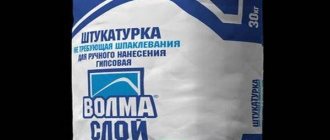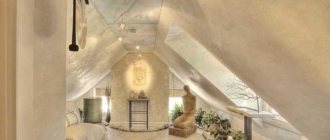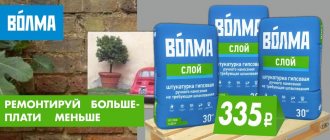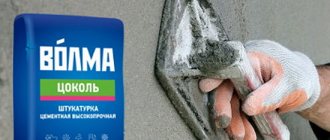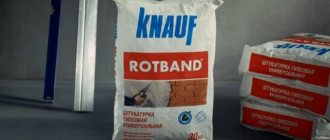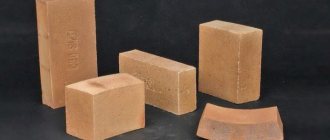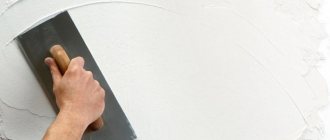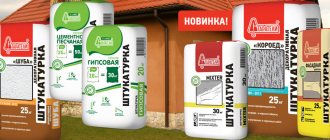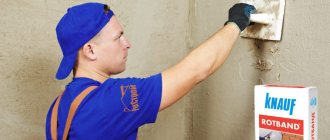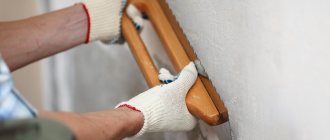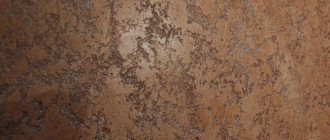Independence. This is the main installation for the Volgograd gypsum plant. He is 70 years old. The enterprise survived the restructuring only by increasing production volumes.
The plant's management avoided dependence on Western companies by not taking their capital for development. Volma represents 100% Russian products. The best seller is to buy plaster. Let's find out whether it evokes a feeling of pride for the country.
Instructions for dilution and application.
The preparation of Volma “Layer” gypsum plaster begins with studying the instructions. Here are essentially the usual steps; it is important to follow the proportions indicated on the packaging. To 1 kilogram of the composition add 600-700 milliliters of liquid. Considering that Volma gypsum plaster is packaged in 30 kg craft bags, it turns out that we need 18-21 liters of water per package.
To begin, pour some water into a convenient container (preferably plastic, it’s easier to work with) to wet the bottom and walls. The mixture is poured to the exact ratio of water according to the proportions. Mixing can be done using a trowel or trowel, but it is much more convenient (much easier for large volumes) to use a construction mixer or a trill with a special attachment. Tools will significantly save time and effort for quality work.
After stirring once, let the solution sit for about 3-5 minutes, this is the period of maturation of the components. After time has passed, stir the diluted mixture again until lumps are completely removed. The consistency should resemble thick sour cream, be plastic, but at the same time not flow off the instrument.
The gypsum composition in question can be used for minor repairs and major interior finishing. The limitation is due to the fact that gypsum, by its nature, absorbs moisture very well, so applying such plaster outdoors is a bad option.
The diluted composition is excellent for: plastering plasterboard, cellular concrete, reinforced concrete slabs, brick and wood.
This plaster is used for:
- restoration work, when minor defects are eliminated;
- minor repairs to level surfaces;
- capital finishing, when work is done from scratch;
- as a finishing coating for leveling before grouting with a sponge float
- creating decorative elements, arches, reliefs or sculptures.
After applying the finishing coat, immediately begin painting or laying ceramic tiles; surfaces coated with Volma “Layer” plaster allow this to be done.
Remember the recommendations on the packaging; the work room should be dry with a temperature range of 5-30 degrees above zero.
Note: If Volma gypsum plaster is applied in rooms with high humidity, then treat it with protective compounds. Do not allow water to come into direct contact with the plaster.
How to breed Volma layer
To dilute 30 kg of dry Volma layer powder, the instructions for use recommend taking 18-19 liters of cold tap water. The water consumption indicated is approximate. Therefore, the consistency of the solution will have to be adjusted to the desired consistency during mixing.
This is due to several factors, for example, to apply the mass in a thick layer, you need a thick consistency. Therefore, to begin with, not the entire specified volume is poured into the container, leaving 3-4 liters separately for finishing (in reserve). If, when mixing, the gypsum plaster turns out to be thick, add liquid from the reserve, adding in portions.
When mixing a smaller mass, the volume specified by the manufacturer is proportionally reduced and a portion is also left in reserve. So for 10 kg of mixture take 6-6.3 liters. The volume of water poured into the container should not occupy more than a third of its volume, otherwise part of the solution will end up on the floor.
A simple rule that is easy to remember: it is correct to pour powder into water, but do not pour liquid into the dry mixture.
Be sure to take cold water. Increasing the temperature of the mixing water dramatically increases the rate of all chemical reactions. Therefore, the lifespan of the solution is reduced, which is undesirable.
Mix the water and powder with a mixer at low speed. Using a spatula or trowel, remove the adhering debris from the walls of the container towards the center and discard it. Stir again until the lumps disappear.
A feature of the process of mixing and hardening of the gypsum composition is its ability to become a “stake” when lumps of old mortar enter. In a fresh solution during the normal course of the process, crystallization centers do not appear immediately, only at a certain stage.
But lumps of previously mixed gypsum already have such centers, therefore, in turn, when they get into a fresh solution (at any stage), they become catalysts for the formation of new centers and serve as them themselves.
For the same reason, you cannot add gypsum powder to the thickening solution. If you want to regulate the consistency, then it is better to dilute the initially thick mixture when mixing, adjusting the density with a water supply.
After the first mixing, the solution is allowed to stand for 3-4 minutes and mixed again. After this, the mass can be applied to the wall.
Nuances of operation
Before applying Aquastandard, carefully prepare the base. Initially, the coating, elements susceptible to shedding, and contamination (oil, bitumen, etc.) are removed. Otherwise they will prevent adhesion.
Pre-treatment of the base with one or two layers of primer of the same brand enhances the strength of fixation.
The dry composition is diluted with water in a ratio of 1 kg: 0.3 ± 0.05 l. To ensure homogeneity of the mass, the mixture is stirred for three minutes. Then it is allowed to “rest” for about five minutes, after which it is mixed again. To do this, use a special mixer or drill with an attachment with a speed of at least 400 rpm. The solution remains usable for approximately two hours.
The ratio of dry matter and water is maintained. Do not use other components to dilute the mixture instead of water.
Primer mixtures The main nuances of performing plastering work:
- The solution is applied with a metal spatula onto a previously prepared base. The layer is 0.1 - 0.3 cm. Defects formed during application are eliminated with abrasive materials, but after the coating has completely dried.
- Re-coating is performed after the first has hardened and primed;
- When finishing the facades, the freshly laid coating is protected from precipitation, cooling, and drying out for three days. Work should not be started in case of strong wind or rain.
Compositions for interior work
Although most mixtures for finishing facades have high performance characteristics and will definitely be able to function in more comfortable conditions in interior spaces, you should not buy them thoughtlessly. Firstly, some types of plaster have insufficient vapor permeability and can worsen the microclimate. Secondly and most importantly, they cost significantly more.
They expect completely different results from interior plaster, so it would be better to choose it according to the following parameters:
1. Light weight.
This requirement is fully met by compositions based on lime or gypsum. Both components are sensitive to moisture, so they can only be used in dry rooms. On the other hand, nothing better can be thought of for wooden bases.
2. Easy to use.
To fulfill this point, the manufacturers themselves tried to create ready-to-apply solutions, usually using polymer binders. The cost of such plaster is quite high, but it performs well as a remixture.
It will hardly be more difficult to work with dry compounds - they need to be mixed with water to obtain a viscous plaster solution. The most popular in this category are gypsum mixtures. In addition, it is a close relative, which means it is an ideal plaster for drywall, which allows you to save a lot on rough leveling of walls.
3. Minimum grain size.
If you do not take into account the decorative finishing, but consider the plaster as a leveling one, then the smallest fractions of the filler can be both an advantage and a disadvantage. It all depends on the condition of the surface
Types of plaster "Volma"
The main product of Volgograd gypsum. She was released first. Starting with the classics, the plant's technologists began to develop improved and highly specialized versions. By 2017, you can find in stores:
- "Plast". It eliminates the disadvantage of rapid hardening of gypsum mixtures. From the moment of mixing to application to the wall, no more than 25 minutes should pass. Plaster "Plast" does not harden 35-40. This makes it possible to dilute large volumes of the mixture into one batch.
- "Canvas". Volma plaster of this category remains in working condition for 180 minutes after mixing, and also has increased viscosity. The latter makes Canvas attractive for leveling ceilings.
- "Assets". Volma plaster is intended for machine application. The “Canvas” and “Plast” lines are designed to be done manually. Machine leveling of walls and ceilings is of better quality, especially when processing large areas. Therefore, “Active” plaster is often purchased for large-scale construction projects.
- "Contact". The building mixture breaks records for adhesion. It is “Contact” that is used for application on smooth substrates. If you sand them first, the plaster will last for decades.
- "Decor". The brand hides plaster, which can be used to form relief surfaces up to stucco.
- "Aqualayer". Volma plaster , in which gypsum is only a minor admixture. The main component is Portland cement. It and polymer additives make the mixture resistant to moisture. When completely immersed within two days, the hardened plaster absorbs only 10% of the water.
- "Aquaplast". It beats Aqualayer in terms of drying time, completely setting in 8 hours versus 24 hours for its competitor. In addition, Aquaplast has 1 point more compressive strength and 0.5 megapascal more bending strength.
- “Socle” is another type of plaster based on Portland cement. The mixture can be applied in a 6-centimeter layer. If thicker is required, plaster in several approaches, each time waiting for complete drying. It comes in 8 hours. The only thing that upsets me is the consumption of the mixture. Per square meter with a coating thickness of 1 centimeter, 12-15 kilograms are consumed. In other cases, the consumption of Volma plaster is 9-10 kilograms.
All types of plaster from the Volgograd plant are universal in terms of surfaces. The mixtures adhere equally well to:
- drywall
- aerated concrete
-brick
-concrete
-cement and gypsum blocks
-lime, cement and gypsum plaster
The last point “speaks” about the possibility of applying “Volma” to old foundations. The main thing is that the previous plaster adheres firmly to the base and does not crack. Otherwise, the adhesion of the layers will be poor.
Application sequence.
Leveling - having thrown the composition onto the wall, they begin to level it using a broad rule using beacons or without them when the wall is more or less even). The rule is from bottom to top, removing all excess and placing it on the recesses.
Trimming is carried out when the gypsum structure has set (after an hour) and acquired hardness. Similar to leveling, the rule cuts off small irregularities in individual areas, directing them into the remaining recesses. Already at this stage you can finish with plaster if your goal is to decorate with wallpaper or tiles. Remember to prime the surface before proceeding with the next type of work.
Smoothing is done with a grater with a sponge surface. It is recommended to start 20 minutes after trimming. After moistening the base with water, begin to move the grater over it until a “milk” forms.
You will immediately feel it when it appears, the friction will increase significantly and it will become more difficult to drive the tool. The resulting substance fills the microcavities and evens out the lunges.
Glossing is the final stage of processing. Here a grater with a metal plane is used. Essentially, the remaining defects on the gypsum surface are rubbed and compacted.
Maintain the full drying time indicated in the instructions; it depends on the temperature and ventilation of the room.
Application of Volma plaster
It is important to work with Volma plasters at temperatures from +5 to +40 degrees. The coatings are ready to serve from -40 to +60 on the Celsius scale.
Before applying the construction mixture, the working surface is cleaned. It is not necessary to remove the old plaster, but it is necessary to clean off the peelings and fill the recesses. You also need to remove dirt and grease stains from the work surface.
They prevent Volma from sticking to the base. Fungus will also become an obstacle. Before plastering, they get rid of it by cleaning it from the bases and treating them with antiseptics.
The presence of moisture in the wall covering provokes corrosion of metal elements. Smudges of rust and yellow spots begin to “emanate” from them. To prevent this from spoiling the finish, metal fasteners and other parts on the walls and ceilings are treated with anti-corrosion compounds.
The rough surface must be dry before applying Volma. The maximum permissible moisture content is 5%. If the requirement is met, we proceed to mixing:
-take a plastic bucket and wet its walls with warm water
- for 1 kilogram of powder poured into a bucket, take 0.6 liters of warm water
-having mixed the first portion with a drill and a “Mixer” attachment, fill it up and add more
- having mixed enough plaster to the consistency of thick sour cream, let the mixture brew for 2-3 minutes
“Volma” is thrown onto the walls with a trowel. Protrusions are removed as a rule. If the base is flat, you can work without beacons. If the walls suffer from level changes, you cannot do without them. Lighthouses are placed at equal intervals. The ends of the rule rest on adjacent planks, cutting the plaster to a given level.
To stick tiles onto plaster, just using a trowel and a rule is enough. If the mixture is used under wallpaper or as a finishing layer, 20 minutes after cutting, “Volma” is smoothed with a spatula and sanded with a brush. Before grinding, the surface is wetted by spraying water from a spray bottle.
When preparing the plaster for painting, after wetting it, use a metal float. It gives a glossy and perfectly smooth surface. If relief is needed, apply pressure in different directions with a spatula or work with a roller with a pattern.
Painting on top of the plaster with brushes is also not prohibited. Also, the building mixture itself is tinted. Initially, it is white and gray, like plaster. It can also be yellowish or pinkish, but grayish rock is mined at the Volma deposits.
Decor on the surface.
You can decorate in different ways, from simple wallpapering to complex techniques of painting on dry plaster. It all depends on your preferences.
- The relief and texture can be set by special rollers. You can also even apply a relief pattern that can be selected on the roller rotor.
- The texture is also set with a simple spatula, alternately pressing on the weakly set gypsum solution. It turns out very beautiful.
- Decorative plaster can make many dreams come true, having a huge selection of options.
- Having the talent of an artist, take up your brushes and paints, create unique and inimitable patterns.
Important! Proceeding to the next stage after applying the plaster, be it wallpaper or tiles. Be sure to saturate the surface with primer, otherwise all your work will go down the drain. The primer will increase the adhesion of surfaces.
Specifications.
The diluted composition has:
- excellent adhesion;
- excellent vapor permeability, which affects air movement in the room;
- environmental friendliness - the basis is natural gypsum;
- no shrinkage.
The presence of good technical characteristics in Volma gypsum plaster has a positive effect on quality. Distinctive characteristics:
- working thickness from 5 to 30 millimeters;
- completion of setting within 3-4 hours;
- complete hardening within a week.
Undoubtedly, everyone has noticed that applying Volma Layer plaster to walls is very simple; you can do it yourself without resorting to the services of repair crews. This will significantly save your budget.
How to plaster walls with volma
Manual application of the Volma plaster layer is similar to the application of any leveling gypsum mixture. At the same time, the gypsum mixture is so environmentally friendly that it can be formed by hand without fear of consequences. Depending on the task and the condition of the base, three application methods are possible: with a spatula (on a flat surface) a thin layer is applied and leveled; as a rule, the mass is applied without beacons where achieving a high-quality finish is not required; Walls with large flaws are leveled along the beacons.
instructions on the packaging volma layer
You might also be interested in an article about ways to level walls.
The temperature of the base and air should not be higher than +30, lower than +5°C. Humidity – no higher than 65%.
It is recommended to start plastering the room from areas where the compounds will dry longer - places opposite windows, doors, heating appliances.
By lighthouses
To plaster the wall, guide strips are used - beacons that form an auxiliary vertical plane. Beacon profiles (metal, plastic, wood or mortar) are placed in increments of 1.0-1.3 m. Since Volma plaster is gypsum, mortar beacons made from the same mortar will be the best. They do not need to be removed after plastering; the main thing is that after making the mortar guides, prime them before plastering.
The dough is slapped from bottom to top between two adjacent planks. Having filled an area of approximately 1 sq. meter area, level the solution using an h-shaped rule, guiding it along the guides. Excess mass is collected on the tool, which is returned with a spatula to the wall where there is less mortar. Having carried out the rule 2-3 times, they continue to fill the gap between the beacons with the solution, then proceed to fill the adjacent path formed by the profiles.
After 40 minutes from the start of mixing, trimming is performed using a trapezoidal rule, with the tip perpendicular to the wall. The rule is moved in the same direction in which the leveling was carried out - from bottom to top. If trimming is carried out across the direction of smoothing, burrs may form.
To accurately determine the timing of the second trim, a test is used that uses the hand, the so-called “lip” test. Touching the surface with your hand leaves a trace of the solution on the palm - linden. The second pruning begins when the linden “goes away” and the surface itself becomes matte. When you press with your finger, marks still remain on the surface, but the dough does not stick to your finger.
Trimming is done with a spatula, moving it perpendicular to the wall. At this stage, the solution “collected” from the surface will be needed to fill the depressions. There is no need to make smoothing movements with the spatula, placing it at an acute angle to the wall. At this stage, only trimming is done, without putting much pressure on the tool.
The instructions for the Volma layer give the maximum values for the thickness of the layer applied in one pass. According to it, a layer of up to 60 mm is applied with a volley. This thickness is only possible on vertical surfaces, in small areas. Moreover, the dough should be thick so that it does not slide down under its own weight.
Putty Volma – Seam
Headings:Volma, Putty
"VOLMA-Shov"
– a dry putty mixture based on natural gypsum binder, modified with mineral and chemical additives that provide high adhesion, water-holding capacity and optimal operating time.
Packing: 5 kg, 15 kg, 25 kg
“VOLMA-SHOV” SPECIAL GYPSUM PUTTER FOR SEALING gypsum board, gypsum board joints and leveling
Application area:
1. For sealing seams of plasterboard and gypsum fiber sheets with thinned edges using reinforcing tape.
2. To correct defects in plasterboard (GVL), cracks, potholes.
Plaster consumption.
Of course, material consumption depends on the curvature of the wall and the thickness of the layer. But, by default, based on the consumption of Volma plaster per 1 m2 with a layer thickness of 1 cm, you will need about 7.5 -9 kilograms.
It is not at all necessary to rely and take this as a basis, because there can be many factors influencing consumption. In order to avoid the mistakes of others, spend a little time on forums about Volma plaster where there are probably reviews about working with it.
Recommendation: Volma “Layer” gypsum plaster is purchased with a small reserve; this action will protect you in future from going to the store again when you are faced with minor surface modifications.
Description and properties of Volma plaster
Volma plaster belongs to gypsum mixtures. They are more flexible than cement ones and dry faster. It takes no more than a week to fully set and gain strength. Gypsum makes up more than 90% of the plaster composition.
This ensures its environmental friendliness. Gypsum is a natural mineral of the group of aqueous calcium sulfates. The thickness of the stone is the result of the gradual settling of animal remains to the bottom of the seas and their compaction under the pressure of water. So the calcium of the bones and the moisture of the oceans form the basis of the gypsum. Sulfur is “thrown up” by streams of underwater sources.
The gypsum is dried before being crushed into a plaster mixture. Left without water, the mineral is ready to greedily absorb it. This is the secret of stirring Volma before applying it to walls and ceilings. Once on them, the plaster just as easily evaporates the moisture.
Particles of crushed gypsum adhere to each other, becoming a semblance of the original rock. In other words, the walls are covered with stone. Its ability to absorb and release water vapor regulates the microclimate of the room. First, excess moisture is locked in plaster, and when the atmosphere dries out, it comes out again.
The main thing is that the layer of Volma plaster does not end up in a room with constantly high humidity. Constantly absorbing water, gypsum becomes damp, swells, becomes affected by fungi, and peels off from rough surfaces.
Storage of the building mixture also requires caution. It is stored in dry rooms. The plaster should be stored hermetically sealed. Even in this form, the mixture retains its quality for only six months.
During this time, the reaction of the powder with moisture from the air that entered the packaging at the factory becomes irreversible. This is a minus of all gypsum plasters. Other characteristics of Volma plaster are a reason to be proud.
When mixed with water, gypsum becomes plastic, easily repeating the shape of the base and spreading over it. At the same time, the construction mixture has excellent adhesion, that is, stickiness. It ensures the penetration of mineral particles into the pores of adjacent materials and microcracks. Plaster not only levels, but also reinforces the base.
Plastering walls with Volma is carried out with a minimum layer of 0.4 centimeters. The maximum is 5 centimeters. This thickness can “stand up” to protect the heat in the house. Gypsum conducts equally poorly both heat and cold.
The reason is the porosity of mineral plaster. There are capsules with air hidden inside it, and it is a poor heat conductor. However, with a layer of plaster of 0.4 millimeters, Volma cannot significantly affect the comfortable temperature in a home or office.
There is no way to apply a thick layer intentionally, without the need to level the walls. This type of thermal insulation is more expensive than conventional insulation and is more difficult to perform and maintain. Similar to the market leader Rotband from Knauf, Volma gypsum plaster does not shrink and does not crack after drying.
Plasticizers help maintain the condition of the elastic film. There are several percent of them in the plaster composition. Plasticizers perfect the adhesion of the mixture. It, like Rotband, can be applied to the base without prior putty. A finishing coat is also not needed, because when Volma dries it acquires a glossy shine.
Professional opinions
People generally respond positively to putty. Consumers note high quality for a relatively small amount. The following video shows the quality of the work performed.
The packaging describes a detailed operating process, which helps during repairs. By following these recommendations, the final result is solid and attractive.
Manufacturers have indicated the ability to omit the puttying process. But builders who have tested the composition in practice note a slight graininess and advise not to neglect the finish. When working with the ceiling and wall slopes, a finely dispersed mixture is additionally applied.
Decorating artists also give positive descriptions of plaster. The homogeneity and softness of the mixture makes application simple and ensures quick drying and reliable fixation with the base.
Other mixtures from the manufacturer.
Volma “Aquaslayer” plaster is a lighter fibrous composition with the presence of Portland cement, polymers and natural components. Like the composition we are considering, it is intended for leveling bases. Already from the name one can judge that it is hydrophobic and can be used in wet areas. Cement plaster Volma "Aquasloy" is used both inside buildings and on their exterior facade.
Compositions with a cement binder are often used as a primary layer, which serves as a reliable base:
- laying ceramic tiles;
- putty and decoration.
There are practically no restrictions on covering bases with Aqualayer; it can be cellular concrete, reinforced concrete products, floor slabs, wooden walls. Volma cement plaster “Aquaslayer” is packaged in 25 kg craft bags.
Volma Aqua-Layer for wet rooms
VOLMA-AQUASLAY — dry lightweight cement leveling plaster mixture based on Portland cement with light aggregates, synthetic and mineral additives that improve the performance properties of the solution, hydrophobized.Scope of application For leveling vertical surfaces and ceilings, making plaster coatings outside and inside buildings, including in rooms with high relative humidity (including under wall tiles). Suitable for use on substrates: foam concrete, aerated concrete, brick and stone masonry, concrete, plaster.
Surface preparation The base must be dry, sound, free from dust, dirt, oil stains and peelings. Large unevenness must be eliminated using the VOLMA-AKVASLOY MN mixture. Treat metal elements with a corrosion-preventing agent. Treat highly absorbent substrates with “VOLMA-Universal” primer; smooth and weakly absorbent surfaces should be treated with “VOLMA-Contact” primer or spray the surface to increase the adhesion of the plaster mixture. For spraying, use the VOLMA-Aquaslayer MN plaster mixture with the consistency of liquid sour cream in a layer of up to 5 mm. At ambient temperatures above 300aC, it is recommended to moisten the base before applying plaster.
Preparation of the solution: Prepare a solution based on the ratio of 0.22-0.24 liters of water per 1 kg of dry mixture. The amount of water depends on environmental conditions and surface porosity. After preparing the solution, you need to check its consistency and add water if necessary.
Method of application: Apply the solution evenly to the entire surface of the base and level with the h-rule. When the solution begins to set (approximately 16-21 hours after preparing the solution), it is necessary to carry out final leveling using a trapezoidal rule, cutting off irregularities and filling in the recesses, and finally rub the surface with a plastic or felt grater, after moistening the surface.
All plastering work must be carried out in dry sunny weather, with light wind and not in strong sun. If work is carried out under unfavorable atmospheric conditions, protective coatings should be used. Plastered rooms must be ventilated, but at the same time protected from drafts and not allowing the surface to dry out quickly.
Storage The dry mixture “VOLMA - AKVASLOY MN” is supplied in 25 kg paper bags, which should be stored on wooden pallets in a dry room. Pour the mixture from damaged bags into whole bags and use first. Guaranteed shelf life in undamaged packaging is 6 months.
Specifications
Color
| grey | ||||
| Base temperature | from +5°С to +30°С | |||
| Open solution time | 2 hours | |||
| Drying time | up to 5 days | |||
| Consumption per 1 m2 with a thickness of 10 mm | 11-12 kg | |||
| Recommended layer thickness | 5-20 mm | |||
| Strength of adhesion to the base (after 28 days) | not less than 0.4 MPa | |||
| Maximum layer thickness | 30 mm | |||
| Frost resistance | at least 35 cycles | |||
| Temperature resistance | from -50°С to +60°С | |||
| Water consumption | 0.22-0.24 l/kg | |||
| Packaging | 25 kg in a bag, 48 pcs on a pallet. | |||
